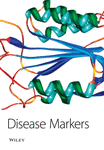Evaluation of Nitric Oxide (NO) Levels in Hepatitis C Virus (HCV) Infection: Relationship to Schistosomiasis and Liver Cirrhosis among Egyptian Patients
Abstract
Nitric oxide (NO), a recently discovered free radical, is overproduced in liver cirrhosis. Hepatitis C virus (HCV) might increase NO levels via increased inducible NO synthase (iNOS). This work was carried out to study the effect of HCV-induced liver cirrhosis on NO levels among Egyptian patients. The study included 46 patients with liver cirrhosis, and 30 healthy individuals of matched age and sex. NO levels determined as the stable endproduct nitrate, showed a statistically significant increase among patients compared to the control group (P < 0.001). Furthermore, NO levels increased proportionally with the severity of liver cirrhosis as assessed by Child’s classification (P < 0.05). Moreover, schistosomial infection enhanced NO levels in cirrhotic patients with HCV infection compared to non-bilharzial patients (P < 0.001). Polymerase chain reaction (PCR) and branched DNA assays were used for detection of HCV RNA positivity, and measurement of the virus load, respectively. Both showed a positive correlation with the NO levels (P < 0.001). At a nitrate cutoff value of 70 μmol/L, the sensitivity and specificity were 83.0% and 37.0% respectively. Chi square analysis showed a significant correlation between ALT levels and both HCV RNA positivity by polymerase chain reaction (PCR) (P < 0.02), and virus load (P < 0.05). Interestingly enough, there was a significant positive correlation between HCV RNA and schistosomal antibody titer as measured by hemaglutination inhibition assay (HAI) (P < 0.05). The data presented in this report indicated an association between NO levels and the development and progression of liver cirrhosis. Furthermore, the findings obtained from this study demonstrated that schistomiasis is an important risk factor involved in enhancement of NO levels and virus replication. The latter may aggravate liver cell injury and hence the development of cirrhosis.




